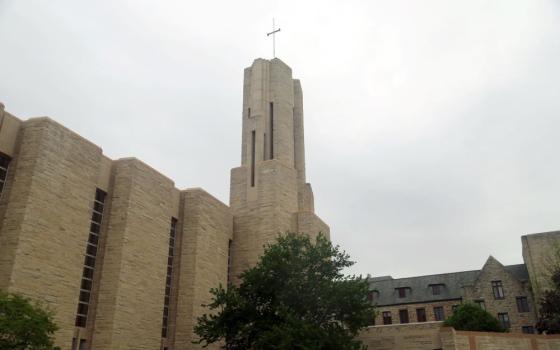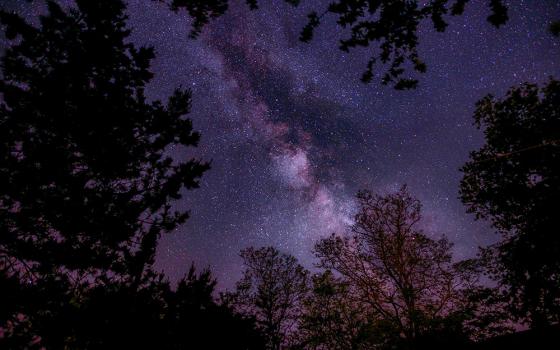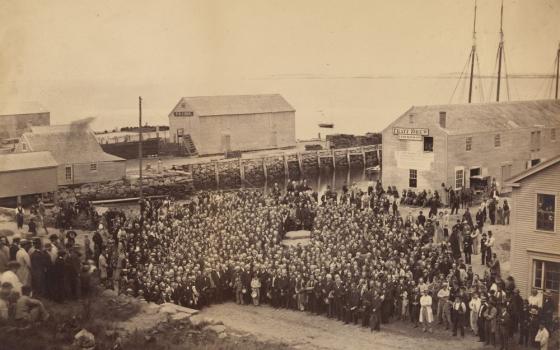By JOHN L. ALLEN JR.
Columbia, South Carolina
One great thing about speaking before a live audience is that you just never know what’s going to happen, especially when it comes to Q&A. That discipline of being kept on one’s toes, being forced to confront what’s on the minds of a wide-cross section of folks, justifies even the agony of airport security screenings and interminable travel delays.
Last night offered a case in point, as I delivered the annual “Bernardin Lecture” sponsored by the Department of Religious Studies at the University of South Carolina. The lecture was launched in 1999 to honor the late Cardinal Joseph Bernardin of Chicago, who was a student at the University of South Carolina. Several of the cardinal’s family members were in the audience last night, en route to Chicago for events marking the anniversary of his death. This year, the lectures also honored Bernardin’s sister, Elaine Addison, who died Sept. 23. She was an active member of the Bernardin Lecture Committee.
As I told the audience, I was deeply honored to speak in a series named for Bernardin, one of the great churchmen of American Catholicism. I spoke on three “mega-issues” facing the church today: the dialogue with Islam, the press for Catholic identity, and the crisis of faith in the West.
As a sampling of what’s on people’s minds, here are three especially interesting questions that popped up afterwards.
First, Waleed El-Ansary, a Muslim and Assistant Professor in the Department of Religious Studies, rose to comment on my description of Pope Benedict’s concern with reciprocity, meaning the problem of religious freedom in majority Muslim states. I had offered the example of Saudi Arabia, where Christians cannot build churches, worship openly, or wear religious insignia without the threat of harassment by the mutawaa, the religious police.
El-Ansary said that because Islamic doctrine stresses the protection of religious minorities, examples to the contrary, such as Saudi Arabia, need to be seen as deviations from proper Islamic teaching rather than as a consequence of that teaching. In the same way, he said, the French prohibition of the Islamic veil should not be seen as representative of Christian teaching on religious freedom.
I replied that I’m hardly an expert in Qu’ranic exegesis or Islamic jurisprudence, so I can’t enter the debate at that level. I do suspect that the problem in places like Saudi Arabia or Iran probably has as much to do with authoritarian government and the logic of police states as it does with the fine points of Islamic doctrine. (After all, there are severe restrictions on religious freedom in authoritarian regimes such as China and North Korea too, which can hardly be blamed on Islam). Nevertheless, even if these are deviations, they are sadly all too frequent deviations, and they still have to be on the table in the Christian/Muslim dialogue – because we have to talk not just about abstract theological concepts, but also the day-to-day reality of life on the ground.
On that point, El-Ansary heartily agreed.
William Thierfelder, President of Belmont Abbey College in Belmont, North Carolina, said he was struck by my description of Benedict’s seeming determination to govern the church from the center. He wondered if the pope’s choice of the name “Benedict” suggested that his approach has been shaped in part by the Rule of Benedict and the broader Benedictine tradition.
Though I’ve never heard the pope connect the dots in quite that way, I said, it’s clear that he’s an admirer of the Benedictine style, which manages to blend deep Catholic roots with a realistic option for the “just mean” in terms of rules and expectations.
As a young man aspiring to the Catholic priesthood, Joseph Ratzinger once considered joining a Benedictine monastery. For many years, the then-Cardinal Ratzinger took his private annual retreat in the Benedictine Abbey of Scheyern, located between Munich and Regensburg in Bavaria. The memory and model of St. Benedict, and the impact the saint had on his times, has thus long been a part of the new pope’s religious imagination and personal spirituality.
Just 24 hours before Pope John Paul II died, the man who would become Benedict XVI was in Subiaco, Italy, home to a famous Benedictine monastery, to receive an honor from Abbot Mauro Meacci – ironically, it was called the Premio San Benedetto, or “St. Benedict Award.” Then-Cardinal Ratzinger delivered a 12-page speech reflecting on the Benedictine rule and spiritual legacy; no doubt preparing this speech was his last really reflective bit of intellectual activity before the whirlwind of events that began with the death of John Paul II on April 2, 2005.
It’s worth quoting at length what Ratzinger said on that occasion:
“What we need above all in this moment of history are people who, through an illuminated and lived faith, render God credible in this world. The negative testimony of Christians who spoke about God but lived against Him has obscured the image of God and has opened the door to disbelief. We need people who keep their gaze directed at God, learning from there what is true humanity. We need people whose intellect is illuminated by the light of God and in whom God opens their heart, so that their intellect can speak to the intellect of others and their heart can open the hearts of others. It is only through people who are touched by God that God will be able to return to the people. We need people like Benedict of Norcia, who, in a time of dissipation and decadence, sank himself into the most profound solitude, succeeding, after all the purifications that he was forced to undergo, in making the light rise again, returning to found Montecassino, the city on the hill where, amid all the ruins, he put together the energies from which a new world was formed. Thus Benedict, like Abraham, became the father of many peoples. The recommendations to his monks placed at the end of his rule are indications that demonstrate also to us the path that leads to the heights, out of the crises and the ruins. ‘Just as there is an evil zeal of bitterness which separates from God and leads to hell, so there is a good zeal which separates from vices and leads to God and to life everlasting. This zeal, therefore, the monks should practice with the most fervent love. Thus they should anticipate one another in honor; most patiently endure one another's infirmities, whether of body or of character; vie in paying obedience one to another – no one following what he considers useful for himself, but rather what benefits another; tender the charity of brotherhood chastely; fear God in love; love their Abbot with a sincere and humble charity; prefer nothing whatever to Christ. And may He bring us all together to life everlasting!’”
I obviously couldn’t recite the passage from memory last night, but it nevertheless responds well to Thierfelder’s perceptive question.
Finally, a young woman from Belgium, whose name I unfortunately didn’t catch, wanted to press me on what I said about the crisis of faith in contemporary Europe. First, she asked, isn’t some of the extreme secularist sentiment one finds in Europe today a product of an overly cozy relationship between church and state in Europe in earlier centuries, which has produced the equal and opposite reaction of wanting to drive religion into a completely private sphere? Second, isn’t part of the reason that the so-called “new movements” have prospered in Europe but not to same degree in the United States precisely because they fill a gap in a depleted European church that doesn’t exist to the same degree in America?
To both questions, I could but respond “Amen.”
Amplifying the questioner’s point, I told the story of a meeting between Cardinal Roger Mahony of Los Angeles and Pope John Paul II, when Mahony asked the late pope why he was such a big supporter of “the movements” – groups such as Focolare, the Neocatechumenate, Regnum Christi, and so on. As Mahony tells the story, John Paul replied that the United States is the only country in the world where the revitalization of the parish intended by the Second Vatican Council (1962-65) had actually happened, so that America perhaps doesn’t need the movements in quite the same way. Given the depleted state of many European parishes, the pope said, the movements remedy an important ministerial deficit.
These are no more than snatches of a much broader conversation, but if nothing else they serve to illustrate the thoughtfulness and interest with which so many American audiences engage religious issues – and that in itself is another reason why, despite everything, I continue to hit the road.




